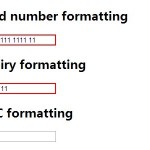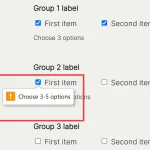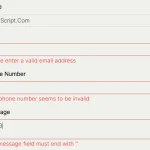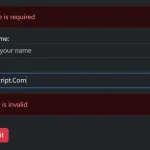| Author: | caneara |
|---|---|
| Views Total: | 281 views |
| Official Page: | Go to website |
| Last Update: | August 25, 2023 |
| License: | MIT |
Preview:

Description:
Iodine is a tiny validation JavaScript library that lets you easily validate data in the browser with a simple API and no dependencies. It supports chainable validation rules so you can verify data meets multiple criteria.
Out of the box, it includes rules for common needs like checking for valid emails, dates, numbers, and more. You can also create custom rules.
How to use it:
1. Install and import the Iodine.
# NPM $ npm i @caneara/iodine
// browser <script src="/path/to/dist/iodine.min.umd.js" defer></script> // ES Module import Iodine from '@caneara/iodine';
2. Initiate a new instance of the Iodine:
const myValidator = new Iodine();
3. Here are the available validation rules in Iodine. Note that all of Iodine’s rules start with assert.
| Rule | Description |
|---|---|
| assertAfter(date/integer) | Verify that the item is a Date after a given Date or timestamp |
| assertAfterOrEqual(date/integer) | Verify that the item is a Date after or equal to a given Date or timestamp |
| assertArray | Verify that the item is an array |
| assertBefore(date/integer) | Verify that the item is a Date before a given Date or timestamp |
| assertBeforeOrEqual(date/integer) | Verify that the item is a Date before or equal to a given Date or timestamp |
| assertBoolean | Verify that the item is either true or false |
| assertDate | Verify that the item is a Date object |
| assertDifferent(value) | Verify that the item is different to the supplied value (uses loose compare) |
| assertEnds(value) | Verify that the item ends with the given value |
| assertEmail | Verify that the item is a valid email address |
| assertFalsy | Verify that the item is either false, 'false', 0 or '0' |
| assertIn(array) | Verify that the item is within the given array |
| assertInteger | Verify that the item is an integer |
| assertJson | Verify that the item is a parsable JSON object string |
| assertMaxLength(limit) | Verify that the item’s character length does not exceed the given limit |
| assertMinLength(limit) | Verify that the item’s character length is not under the given limit |
| assertMax(limit) | Verify that the item’s numerical value does not exceed the given limit |
| assertMin(limit) | Verify that the item’s numerical value is not under the given limit |
| assertNotIn(array) | Verify that the item is not within the given array |
| assertNumeric | Verify that the item is number or a numeric string |
| assertOptional | Allow for optional values (only for use with multiple checks) |
| assertRegexMatch(exp) | Verify that the item satisfies the given regular expression |
| assertRequired | Verify that the item is not null, undefined or an empty string |
| assertSame(value) | Verify that the item is the same as the supplied value (uses loose compare) |
| assertStartsWith(value) | Verify that the item starts with the given value |
| assertString | Verify that the item is a string |
| assertTruthy | Verify that the item is either true, 'true', 1 or '1' |
| assertUrl | Verify that the item is a valid URL |
| assertUuid | Verify that the item is a UUID |
// true
myValidator.assertInteger(7);
// false
myValidator.assertInteger('cssscript.com');4. Apply multiple rules to your data.
// true
myValidator.assertInteger(7, ['required', 'integer']);
// false
myValidator.assertInteger('cssscript.com', ['required', 'integer']);// multiple items
const items = {
name: CSSScript,
email: '[email protected]',
password: 'abcdefgh',
};
const rules = {
name: ['required', 'string'],
email: ['required', 'email'],
password: ['required'],
};
myValidator.assert(items, rules);// additional parameters myValidator.assert(7, ['required', 'integer', 'min:5']);
// Optional values myValidator.assert(7, ['optional', 'integer']);
5. Replace default error messages:
// Custom Errors
myValidator.setErrorMessages({
same : `[FIELD] must be '[PARAM]'`
});
// Single Errors
myValidator.setErrorMessage('passwordConfirmation', 'Does not match password');
// Custom Errors by Field
myValidator.assert(value, ['required'], { 'required' : 'The "Label" must be present.' });6. Add custom rules using the rule function:
// Simple
myValidator.rule('newRule', (value) => ());
// With parameters
myValidator.rule('newRule', (value, param) => ());









